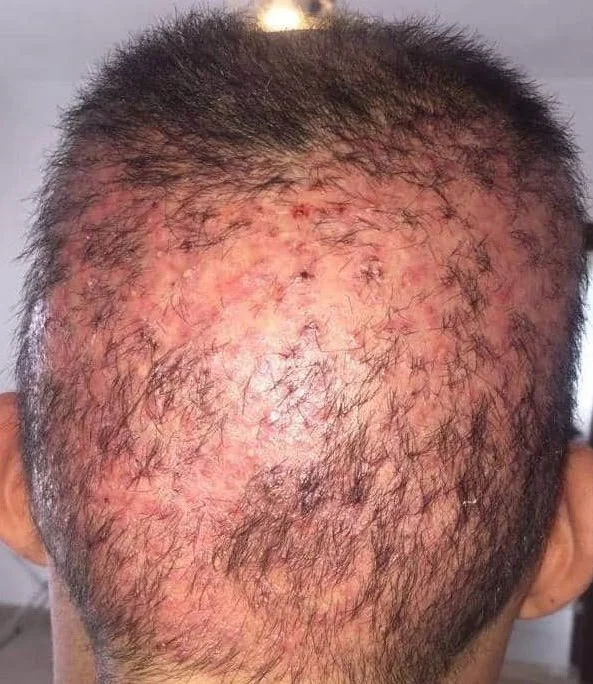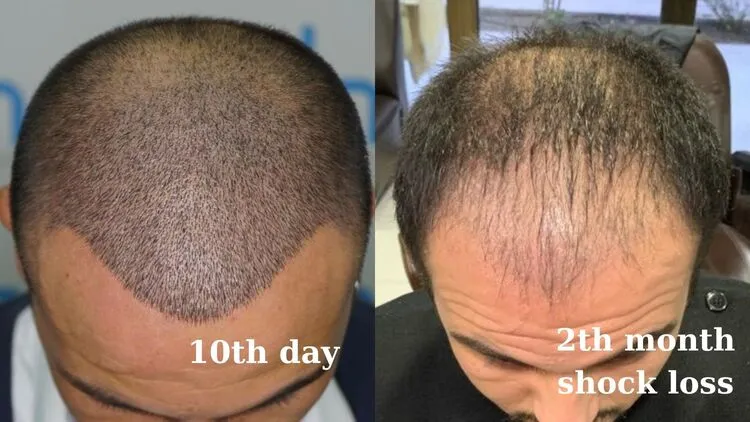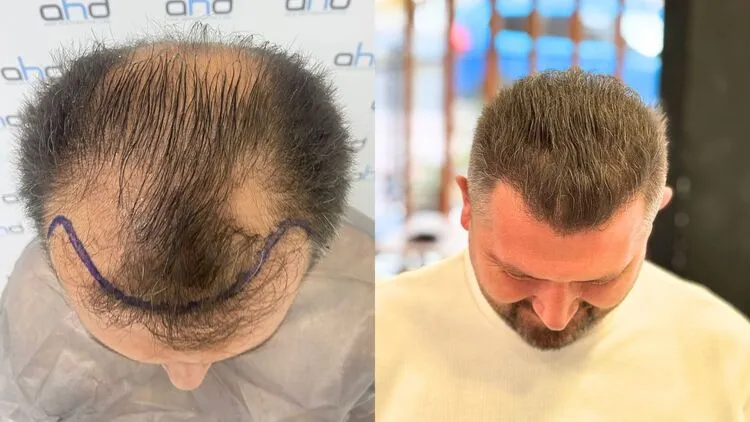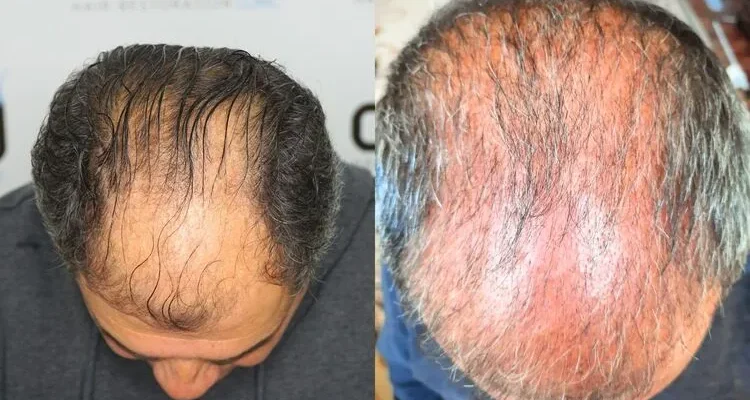After a hair transplant, some of the transplanted hair may shed for various reasons. The primary reason for this is the trauma experienced by the hair follicles. This sudden and temporary condition is called shock loss. In this article, we will provide detailed information about the causes, duration, and ways to minimize shock loss. Although this process is something that men and women who have had a hair transplant neither want nor worry about, it is completely normal. This is because the hair that falls out due to shock will regrow after a while and continue to grow.

What Causes Shock Loss After a Hair Transplant?
Your hair’s normal growth cycle occurs in 4 alternating phases. These phases are as follows:
- Anagen Phase (Growth Stage): This is the stage when a hair follicle is at its strongest and hair grows the fastest. This phase lasts approximately 2 to 5 years.
- Catagen Phase (Transition Stage):
- Telogen Phase (Resting Stage):
- Exogen Phase (Shedding Stage):
Regarding the hair transplant procedure;
- Local anesthesia is applied to both the donor and recipient areas.
- While the hair follicles are being extracted from the donor area, their connection to the blood vessels is severed. Consequently, the nourishment of the hair follicles through the blood supply is halted.
- Subsequently, numerous incisions are made in the recipient area, and these hair follicles are transplanted into them.
These three specified conditions represent a trauma for the hair follicle. Hair that undergoes such trauma goes into shock. In other words, these hair follicles in the anagen, catagen, and telogen phases react prematurely and transition into the exogen phase. Consequently, the hairs that undergo a phase change due to the trauma temporarily enter a resting and shedding stage, leading to a condition known as shock loss. In medical literature, this is called “telogen effluvium.”
The shock shedding mechanism can also be explained as follows. Since the hair is traumatized, the body’s defense mechanism perceives this as an attack. It then takes action to protect the hair against the attack. The hair breaks off from the ends and goes into a dormant state under the skin. However, the hair follicles under the skin are intact and wait for their time to emerge.
In Which Areas Does Hair Shedding Occur After a Hair Transplant?
It has been determined that shedding may occur in 3 areas after a hair transplant. These areas are as follows:
- Hair Loss in the Recipient Area of Transplanted Grafts: This refers to the shedding of the transplanted hair, which is the main topic of this article and is completely normal. In other words, hair grafts can temporarily fall out due to the trauma of the procedure.
- Hair Loss of the Person’s Existing Hair in the Recipient Area: This situation can occur when a density procedure is performed among existing hair that has not completely fallen out but is sparse. The fine, weak hair follicles surrounding the newly transplanted grafts may shed during the hair transplant procedure. The person’s own fine hair can also go into shock due to the trauma and fall out. If this condition is temporary, it can also be considered normal, and the shed fine hair will grow back. However, if large incisions are made in the recipient area, vascular damage increases, and the existing fine hair may sustain permanent damage.
- Hair Loss in the Donor Area: When grafts are extracted from the donor area using the FUE method, the blood supply to the surrounding hair follicles can be interrupted. Thus, these traumatized hairs can also experience shock loss. This is actually a situation resulting from incorrect graft extraction. When an excessive number of grafts are taken from the donor area, the neighboring hair follicles can also be significantly damaged. Particularly, if too many grafts are taken from above the ears, a condition called “tissue reaction” can occur in this area, leading to a permanent deformity. In FUT hair transplantation, while the tissue strip is being excised, the hair follicles around the incision area can also be damaged. Permanent hair loss in a linear pattern can be observed in this area.

When Does Shock Loss Start?
The hair transplanted 10 days after washing is completely cleared of scabs. Patients are usually very happy with the 10-day appearance. In fact, they think, “I wish it would stay like this.” But unfortunately, it doesn’t continue like this forever. About 2 weeks after the transplant (between the 15th and 20th days), shedding slowly begins. This period can last up to 3 months.

The timeline for shock shedding
This period, which begins in the 2nd week, can last until the end of the 3rd month. If we look at what will happen in this phase:
Weeks 2-3: Thinning of the transplanted hair begins after the 10th day due to the shedding phase. From the 2nd week onwards, a slight, vague shedding of the hair gradually begins. In the 3rd week, the shedding continues and accelerates.
Week 4 (1 Month): It continues rapidly. Many patients become anxious, thinking, “Will my shed hair grow back?” Do not worry or stress.
Weeks 4-8 (Months 2-3): By the end of the 2nd month, the shock loss has peaked. In some people, almost all of the transplanted hair is seen to have shed. This can continue until the 3rd month.
Below, you can see a 3-month photo of a patient who experienced shock loss.

Month 4: The shock loss period has now ended, and the growth of new hair has begun. The initial hairs that emerge are fine and weak.
Months 6-12: By the end of 6 months, at least half of the transplanted hair will have grown in. Over time, the hair continues to increase in both number and thickness. After 1 year, the growth rate of the hair is expected to be at least 95%.
In the picture above, you can see the 1-year result of the patient who had a 3-month shock loss appearance.

Factors That Increase or Decrease Shock Loss
Let’s not forget that shock loss can never be completely prevented in any way, and it does not occur at the same level in every person who has a hair transplant. Therefore, it would not be correct to give a specific percentage for the rate of shedding after a hair transplant. Some people may get through this period with very little shedding. In others, almost all of the transplanted hair may be shed. However, according to the experiences of surgeons who perform hair transplants, some factors that reduce or increase the severity of shedding have been identified. These factors are as follows:
- Age and Gender
- Finasteride and Minoxidil (before and after hair transplantation)
- Doctor’s Surgical Experience
- Graft Count and Operation Duration
- Local Anesthesia and Adrenaline Dose
- Angle of Incisions in the Recipient Area
- Size of the Incisions Made
- Graft Density
Now let’s examine these factors in more detail.
- Age and Gender: In hair transplants performed at early ages, it has been observed that shock loss is more prevalent. This is because androgenic activity is higher at younger ages, creating a hormonal pressure on the hair. However, this is not an absolute rule. Furthermore, it has been determined that shock loss is seen at a higher rate in men compared to women.
- Use of Finasteride and Minoxidil: It has been scientifically proven that shock loss is less common in patients who use finasteride and minoxidil before and after the hair transplant. Since finasteride reduces testosterone pressure through a hormonal mechanism, resistance against shock loss increases. As for minoxidil, it increases blood flow in the treated area, enhancing the nourishment of the hair via the bloodstream and consequently reducing the rate of shock loss.
- Surgeon’s Experience: All the factors we will mention from this point onward depend on the experience of the surgeon who will perform your hair transplant. A good hair transplant surgeon performs the operation in accordance with medical rules, which minimizes the risk of permanent shock loss.
- Graft Count and Operation Duration: As the number of grafts increases, the operation time will lengthen. As the duration extends, the dose of local anesthesia to be applied to the donor and recipient areas will also increase. Consequently, the trauma inflicted on the scalp increases. These are situations that trigger each other in a chain reaction. A hair transplant should be completed within a maximum of 8 hours. Within this time frame, an average of 2000 – 2500 grafts can be transplanted. If a high number of grafts, such as 4000-5000, is planned, it would be correct to divide this into two days. Because in operations with a high graft count and long duration, the likelihood of the hair going into shock loss increases further. If an excessive number of grafts are taken by exceeding the donor area’s capacity, a permanent and undesirable poor appearance will occur in the donor area.
- Local Anesthesia and Adrenaline Dose: The adrenaline contained in local anesthetics constricts blood vessels and minimizes potential bleeding. However, if the procedure takes too long, re-administering anesthesia becomes necessary, which means the adrenaline dose increases. Prolonged constriction of blood vessels reduces blood flow, impairs tissue nourishment, and causes ischemia in the tissue. This increases the risk of necrosis in that area. Necrosis is an undesirable complication in hair transplantation resulting from the tissue being deprived of oxygen. This condition can cause permanent hair loss in both the donor and recipient areas. Therefore, using high doses of local anesthetic in hair transplantation is not correct, as it is a factor that increases shock loss. In transplants performed with the DHI method, since bleeding will be minimal, there is no need for extra adrenaline use. Hence, the risk of necrosis and permanent hair loss is quite low in the DHI method.
- The Angle of the Incisions in the Recipient Area: This is very important if a densification transplant is to be performed between sparse hair. The angle of the incisions made must be parallel to the angle of the existing hair. Otherwise, the surrounding neighboring hair follicles will be damaged, and temporary shock loss may become permanent.
- The Size of the Incisions Made: If the needle tip or the diameter of the blades used to make the incisions is larger than necessary, the distance between the incisions will inherently be wider. This results in a low-density hair transplant. In a limited area, incisions made with large-diameter blades cause more trauma. In an area with more vascular damage, the risk of permanent loss for hairs that go into shock will also increase.
- Graft Density: As the number of grafts per cm² increases, the probability of permanent or temporary shock loss will also increase. Therefore, creating the smallest possible incisions and performing a denser hair transplant is a more correct choice. In a single session, by creating small incisions, an ideal density can be achieved by placing an average of 40 grafts per square centimeter. If higher density is desired, planning a second transplant session one year later would be more appropriate.
The Differences Between Temporary and Permanent Hair Loss
Temporary shock loss begins 2-3 weeks after a hair transplant and is considered a phase of the recovery period. However, if the hair loss is due to obvious mistakes made during the operation, these hairs may be lost permanently and may not grow back. Now, let’s summarize these two types of hair loss and the differences between them in a table.
| Feature | Natural Shock Loss | Permanent Hair Loss (Faulty Hair Transplantation) |
|---|---|---|
| Donor Area | If the graft extraction correctly and in a balanced way, there will be no shedding in the donor area. | Permanent deformity can occur due to faulty hair graft harvesting. |
| Recipient area | There is shedding, but the shed hair follicle is not damaged. These will grow back. | Areas of necrosis can occur due to faulty hair transplantation. The shed hair does not grow back. |
| Duration / Period | It’s only temporary. Your hair will start to grow back in 3-4 months. | There will be no new hair growth. |
| View | When new hair starts to grow, it creates a thin but uniform appearance. | Patchy, empty necrotic areas are observed. |
| Hair growth | Hair grows and thickens in a balanced manner. | Since the hair follicles are permanently damaged, hair does not grow and cannot regrow. |
You can see below the image of a patient with 3 months of shock hair loss and their image after 1 year.

What Should You Do During The Shock Shedding Period?
It will be beneficial for you to follow some advice in order to get through this process as easily as possible.
- Follow your doctor’s recommendations. Use the medications prescribed to you regularly. We had previously mentioned the shock loss reducing effects of Minoxidil and Finasteride.
- Especially during the first month, avoid strenuous activities that increase sweating. Discontinue heavy exercises that may increase the risk of trauma to the scalp area for at least 1 month.
- For the first 10 days, wash your hair gently, as if caressing a baby’s head, and avoid washing it harshly. In the initial washes, do not use shampoos containing sulfates and harsh chemicals.
- After the 10th day, you can gently massage your scalp. This may help increase blood flow. The increased blood flow will also enhance the nourishment of the hair through the blood.
- After the hair transplant, PRP treatment can accelerate hair growth.
- Don’t stress: Hair loss after the operation is a normal condition seen during the recovery period. Everyone who has a hair transplant will experience shock loss, to a greater or lesser extent. After the shock loss period is over, the only thing left to do will be to wait patiently.
FREQUENTLY ASKED QUESTIONS
Can Hair Loss Be Prevented?
Everyone who has a hair transplant inevitably goes through this period. Shock loss cannot be completely prevented. However, if an experienced hair transplant doctor performs the operation correctly, the hair loss can be minimal.
Is Shock Loss Permanent?
After a hair transplant, hair shedding is normal, and these hairs begin to grow back after 3-4 months. However, in operations performed by inexperienced individuals, if the hair follicles are damaged, these hairs fall out and do not grow back permanently. In operations performed at AHD clinic, shock loss is minimal. This is because all procedures are carried out in accordance with the rules. At AHD clinic, we have never experienced permanent hair loss.
Does shock loss affect the success rate of a hair transplant?
Temporary shedding does not affect the final result. The hair will grow back. However, if hairs prone to shedding in the telogen phase are taken from the donor area, these hairs may not grow back after being transplanted. Therefore, thick and strong hairs must be taken from the donor area.
How Long Does Shock Loss Last?
Shedding, which usually starts after the 2nd week, can continue until the 3rd month. Shedding is expected in the vast majority of the transplanted hair by the end of the 2nd month.
Will My Own Hair Fall Out After a Hair Transplant?
During a hair transplant for thinning hair, some of the transplanted hair may shed. If your own hair follicles have not been damaged, these hairs will also grow back.
What is the Shape of the Shed Hair?
After a hair transplant, hair loss can occur in 3 patterns. You may experience hair loss in the shape of an L (like a club), an I, or a J.
Is It Possible to Have No Hair Loss After a Hair Transplant?
After a hair transplant, some of your hair will inevitably go into shock and fall out. In some people, almost all of the hair may shed. In others, a maximum of about 10% may fall out. Since this ratio is not very noticeable, some people think their hair didn’t fall out at all after the transplant. If there is no shedding or if it is minimal, the desired result is achieved more quickly.
Is it good if shock loss starts early?
Whether hair loss starts early or late has no positive or negative effect on the outcome. No scientific evidence has been published on this matter.

